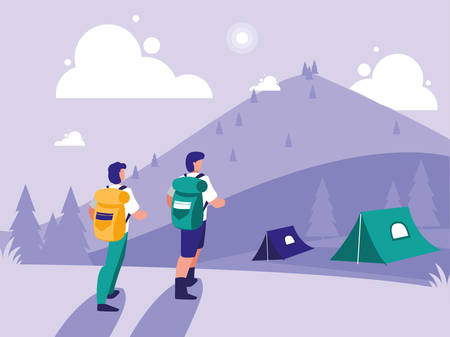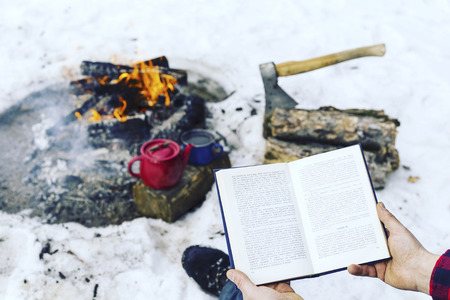1. Choosing the Right Campsite
When it comes to winter camping in a tent, choosing the right campsite is one of the most important steps to staying warm and safe. The location you pick can make or break your cold-weather adventure. Here are some key things to keep in mind when selecting your spot:
Look for Natural Wind Protection
Winter winds can seriously chill you, even inside a well-insulated tent. Try to find a site that offers natural windbreaks like trees, hillsides, or large boulders. Avoid camping on high ridges or wide-open spaces where wind can hit you directly.
Avoid Avalanche-Prone Areas
If youre camping in mountainous terrain, its crucial to avoid areas that are prone to avalanches. Steer clear of slopes between 30° and 45°, especially after recent snowfall or warming temperatures. Always check avalanche forecasts and maps before heading out.
Choose Safe and Level Ground
Set up your tent on flat ground to avoid sliding around during the night. Also, make sure there aren’t any overhanging branches or unstable snowbanks above your site that could collapse under weight or wind.
Stay Close to Resources
Pick a location near resources like firewood (if allowed), water sources (like a frozen lake or river), and natural cover. However, be careful not to camp too close to water, as temperatures can drop lower and condensation might become an issue.
Quick Guide: What to Look for in a Winter Campsite
| Campsite Feature | Why It Matters |
|---|---|
| Natural Windbreaks | Helps reduce wind chill and keeps your tent warmer |
| Avalanche Safety | Keeps you out of harm’s way in mountainous regions |
| Flat Terrain | Provides stability for sleeping and cooking |
| Proximity to Resources | Makes gathering firewood and water easier |
Pro Tip:
If youre unsure about the safety of an area, its always better to move on and find another spot. Trust your instincts and stay informed with local weather and safety updates.
2. Gear Up: Essential Winter Camping Equipment
When it comes to winter camping in a tent, having the right gear can make or break your trip. Cold temperatures, snow, and wind demand equipment that’s built for harsh conditions. Here’s a breakdown of essential winter camping gear you’ll need to stay warm and safe out there.
Four-Season Tent
Unlike regular three-season tents, four-season tents are designed to handle heavy snow loads and high winds. They typically have stronger poles, more robust fabrics, and fewer mesh panels to keep warmth in and the elements out. Look for a tent with a full-coverage rainfly and good ventilation to reduce condensation inside.
Insulated Sleeping Pad
The ground can sap your body heat faster than cold air. A high-quality insulated sleeping pad creates a barrier between you and the frozen ground. Look for pads with an R-value of 4 or higher for winter use.
Sub-Zero Sleeping Bag
A winter-rated sleeping bag is crucial for staying warm overnight. Choose a mummy-style bag rated at least 10°F lower than the lowest temperature you expect. Down insulation is lightweight and compressible, while synthetic insulation performs better in wet conditions.
Moisture-Wicking Base Layers
Your base layer is your first line of defense against the cold. Avoid cotton—it holds moisture and can make you colder. Instead, go for moisture-wicking materials like merino wool or synthetic fibers that keep sweat off your skin and help regulate body temperature.
Quick Gear Comparison
| Gear | Recommended Features | Why It Matters |
|---|---|---|
| Four-Season Tent | Strong poles, low mesh, full rainfly | Withstands snow and wind, retains heat |
| Insulated Sleeping Pad | R-value 4+ | Prevents heat loss to the ground |
| Sub-Zero Sleeping Bag | Mummy shape, rated below temp range | Keeps you warm during freezing nights |
| Base Layers | Moisture-wicking (merino wool or synthetic) | Keeps skin dry and maintains warmth |
Extra Tip:
Don’t forget accessories like a warm hat, insulated gloves, wool socks, and a reliable headlamp. These small items make a big difference when temperatures drop after sunset.

3. Layering and Clothing Tips to Stay Warm
Staying warm while winter camping in a tent is all about smart layering. When temperatures drop, your clothing can make or break your experience. The key is to trap body heat while staying dry. Heres how you can master the art of layering for cold-weather camping.
Understanding the Layering System
The layering system includes three essential layers: base, middle, and outer. Each plays a unique role in keeping you warm and dry during your winter adventure.
Base Layer – Moisture Management
The base layer is worn directly against your skin and its main job is to wick moisture (sweat) away from your body. Avoid cotton—it holds moisture and will make you cold. Instead, choose thermal underwear made from synthetic materials or merino wool.
Middle Layer – Insulation
This layer provides insulation by trapping heat close to your body. Fleece jackets, down vests, or insulated sweaters work great here. You can even double up on this layer if its extremely cold.
Outer Layer – Weather Protection
The outer layer shields you from wind, snow, and rain. A good waterproof and breathable shell jacket and pants are essential to stay dry and block out the elements.
Layering Guide
| Layer | Main Purpose | Recommended Materials |
|---|---|---|
| Base Layer | Wick sweat away from skin | Synthetic fabrics, Merino wool |
| Middle Layer | Trap body heat | Fleece, Down, Synthetic insulation |
| Outer Layer | Protect from wind and water | Waterproof/Breathable shells (GORE-TEX) |
Extra Tips for Staying Warm with Clothing
- Dress in layers: You can always remove a layer if you get too hot.
- Keep extremities covered: Wear insulated gloves, thick socks, and a warm hat—most body heat escapes through your head and feet.
- Avoid sweating: If you feel too warm while hiking or setting up camp, shed a layer to avoid getting damp.
- Sleep in clean, dry clothes: Change into fresh layers before going to bed to stay warm overnight.
- Puffy jacket = lifesaver: A lightweight down or synthetic puffy jacket is perfect for staying cozy at camp.
Dressing properly with the right layers not only keeps you comfortable but also prevents dangerous conditions like hypothermia or frostbite while winter camping in a tent.
4. Staying Warm Inside Your Tent
When youre winter camping, staying warm inside your tent is one of the most important parts of having a safe and enjoyable trip. Even if you have a solid four-season tent, it wont keep you warm on its own—you need to take some smart steps to create and maintain heat through the night.
Insulate Your Tent Site
The ground can suck away your body heat fast, especially when its frozen or covered in snow. Add layers between you and the cold earth:
| Insulation Layer | Purpose |
|---|---|
| Foam sleeping pad | Provides basic insulation from the ground |
| Inflatable sleeping pad (R-value 4+) | Adds extra warmth; higher R-value means better insulation |
| Tarp or space blanket under tent | Keeps moisture out and adds another layer of protection |
Create Heat with Hot Water Bottles
A simple trick that works wonders: fill a sturdy water bottle with hot (not boiling) water before bed and place it in your sleeping bag. Put it near your core, between your thighs, or by your feet to help warm your body fast. Just make sure the lid is tightly sealed to avoid leaks.
Avoid Condensation by Maintaining Airflow
You might be tempted to seal up every vent to keep warm air in, but that can lead to condensation. Moisture from your breath will collect inside the tent, making everything damp—and cold. Instead, leave a small vent or window cracked open to allow airflow. It helps reduce frost buildup and keeps your gear dry overnight.
Manage Your Body Heat Efficiently
Your own body is a great heat source—if you trap that heat properly. Here are a few tips:
- Wear dry base layers: Change into clean, dry clothes before bed to avoid getting chilled by sweat-soaked layers.
- Avoid overdressing: Too many layers can cause sweating, which leads to getting cold later. Dress in breathable insulation instead.
- Add a hat or balaclava: You lose lots of heat through your head—cover it up!
- Eat a high-calorie snack before bed: Your body needs fuel to generate heat while you sleep.
If you wake up cold at night, do a few quick movements (like sit-ups or flapping arms) inside your sleeping bag to warm up without needing to get out into the cold.
5. Winter Safety and Emergency Preparedness
Winter camping in a tent can be an amazing adventure, but its important to be ready for the risks that come with cold weather. Conditions like frostbite, hypothermia, and sudden snowstorms can turn dangerous fast if youre not prepared. Heres how you can stay safe and handle emergencies when youre out in the cold.
Recognize Cold-Weather Health Risks
Understanding the signs of common cold-weather issues helps you act quickly before things get serious.
| Condition | Symptoms | What to Do |
|---|---|---|
| Frostbite | Numbness, pale or grayish skin, hard or waxy feel | Warm affected area slowly, avoid rubbing skin, seek shelter |
| Hypothermia | Shivering, confusion, slurred speech, fatigue | Get into dry clothes, warm up with blankets or body heat, drink warm fluids if alert |
Pack Essential Emergency Gear
Your winter camping gear should include items that help you deal with unexpected situations. Heres a checklist of must-have safety gear:
- First aid kit: Include items for cuts, burns, and blisters, plus emergency medications.
- Emergency bivvy sack or space blanket: Provides quick warmth and wind protection.
- Headlamp with extra batteries: Cold drains battery life quickly—bring spares!
- Fire-starting tools: Waterproof matches, fire starter cubes, and a lighter.
- Multi-tool or knife: Useful for repairs or survival needs.
- Backup food and water: High-calorie snacks and insulated bottles to prevent freezing.
- Trekking poles or snowshoes: Helps in deep snow or icy terrain.
Create a Communication Plan
If something goes wrong, youll want a way to call for help. Always let someone know your trip details before you head out. Here are some tips for staying connected:
- Tell someone your plan: Share your route and expected return time with a friend or family member.
- Use GPS or personal locator beacons (PLBs): These devices can send SOS signals even without cell service.
- Keep phones warm: Store them close to your body to extend battery life in cold temperatures.
Pro Tip:
A printed map and compass are great backups in case technology fails. Practice using them before your trip!
Watch the Weather—and Be Ready to Turn Back
The weather can change fast in winter. Always check forecasts before heading out and monitor conditions during your trip. If a storm rolls in or temps drop too low, don’t hesitate to pack up early—your safety is more important than sticking to the plan.
Your Safety Checklist Before You Go:
- [ ] Checked weather forecast for full trip duration
- [ ] Shared trip details with someone at home
- [ ] Packed emergency shelter and warming supplies
- [ ] Brought navigation tools (map/compass/GPS)
- [ ] Tested communication devices and backup power sources
The key to safe winter tent camping is being prepared for anything. With the right knowledge and gear, you’ll be ready to handle whatever nature throws your way.


